#ho-chunk history
Explore tagged Tumblr posts
Text
SHARICE DAVIDS // POLITICIAN
“She is an First Nations (Ho-Chunk) attorney, former mixed martial artist and politician serving as the US representative from Kansas’ 3rd congressional district since 2019. She’s a member of the Democratic Party. She is the first openly LBGT Native American elected to US Congress, the first openly lesbian person elected to the US Congress from Kansas and one of the first two Native women elected to Congress.”
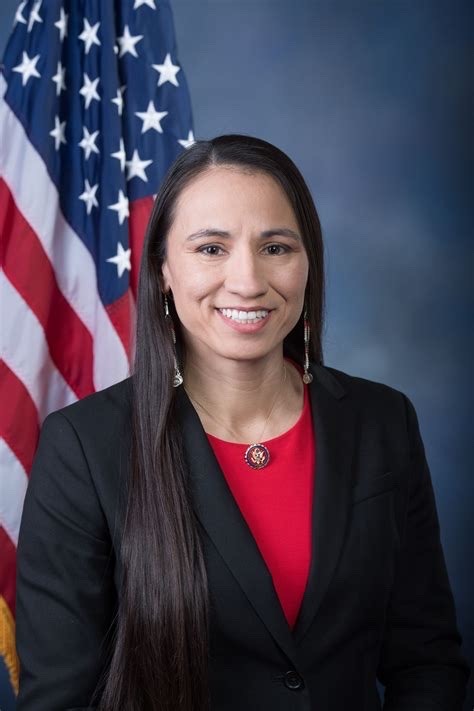

#female history#indigenous history#lgbt history#women’s history month#ho-chunk history#sharice davids
0 notes
Text
Native American Heritage Month at UWM Archives
In honor of Native American Heritage Month, we offer this selection of materials from our collections that begin to illustrate Native American presence and power at UWM.

📸: Sandra Harris Tran tables for the Native American Student Movement (NASM) at UWM, circa 1980. The NASM has been a key vehicle for Native student organizing, support, and expression since the late 1960s. NASM is now known as the American Indian Student Association. Call Number: UWM Photographs Collection, UWM AC 6, Box 18.

📸: A Milwaukee Sentinel clipping pictures American Indian students organizing for a dedicated academic program outside Chapman Hall in 1971. Call Number: UWM University Communications & Media Relations Records, UWM AC 134, Box 2.

📸: The cover to a 1974 catalog shows the fruits of Native student organizing in the form of the UWM Native American Studies Program (now American Indian Studies). Call Number: UWM Office of the Chancellor Records, UWM AC 46, Box 54.
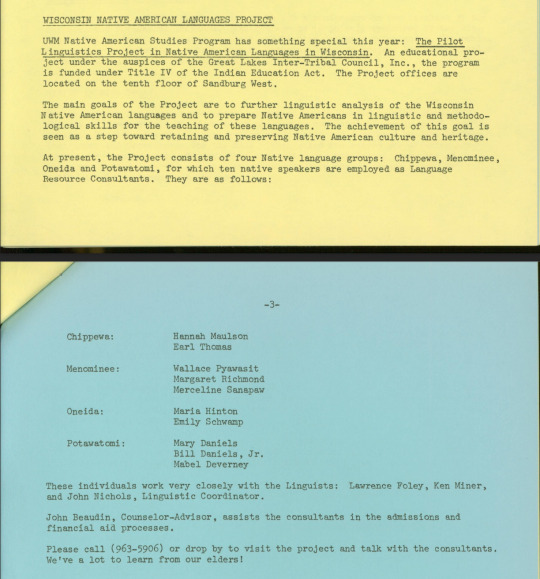
📸: The UWM Native American Studies Program announces the pilot of the Wisconsin Native American Languages Project (WNALP) in 1974. This announcement is from "Anishinaabe News: UW-Milwaukee American Indian News," a newsletter of the Native American Studies Program and NASM. Call Number: UWM Office of the Chancellor Records, UWM AC 46, Box 54.

📸: Margaret Richmond offers language instruction to a class of Native "youngsters" as a Menominee Language Resource Consultant for the WNALP in 1976. Call Number: UWM Photographs Collection, UWM AC 6, Box 18. The earlier Native American Studies Program WNALP announcement anticipates an appropriate caption: "We've a lot to learn from our elders!"
In cooperation with the Great Lakes Intertribal Council, UWM Archives stewards the Wisconsin Native American Languages Project Records, 1973-1976 (UWM Mss 20). With extensive instructional materials from the WNALP, the collection continues to serve as an important resource for the study and revitalization of Wisconsin's Native languages for citizens of Wisconsin's Ojibwe, Menominee, Oneida, Potawatomi, and Ho-Chunk nations.
#uwm archives#Native American Heritage Month#Native American Studies#Ojibwe#Menominee#Oneida#Potawatomi#Ho-Chunk#teaching#learning#language revitalization#archives#special collections#uwmdistcoll#history#photography#newspapers#Wisconsin history#Milwaukee history#uwm#American Indian Studies
14 notes
·
View notes
Text
That Midwest Magick

Witchcraft in the American Midwest is a complex blend of indigenous traditions, European folk magick, spiritualism, and the influence of modern witchcraft movements. Unlike New England, which is infamous for its witch trials, the Midwest has a more subtle but rich history of magickal practices, folk beliefs, and occult traditions that have shaped the region’s spiritual landscape.
Indigenous Traditions and Early Beliefs
Before European settlers arrived, the Midwest was home to numerous Native American tribes, including the Lakota, Ojibwe, Potawatomi, and Ho-Chunk. Many indigenous spiritual traditions involved rituals, spirit communication, and herbal healing, practices that were later viewed as "witchcraft" by European settlers.
Common Indigenous Spiritual Practices:
Shamanic Healing - Medicine people or shamans used herbs, songs, and rituals to heal illnesses and communicate with spirits.
Dreamwork & Vision Quests - Dreams and visions were seen as powerful messages from the spirit world.
Shape-shifting Legends - Many tribes had stories of beings that could transform between human and animal forms, such as the Wendigo or the Skinwalker.
When settlers arrived, they often misunderstood these practices, sometimes labeling indigenous spiritual leaders as witches or sorcerers. The suppression of indigenous spirituality through boarding schools and forced Christianization led to many traditional practices being hidden or adapted.

European Settlers and Folk Magick
The Midwest was settled by diverse groups, including Germans, Scandinavians, Irish, and Eastern Europeans, each bringing their own folk magick traditions.
German Powwow & Braucherei - German immigrants brought Powwow (also called Braucherei), a Christian folk magick system that blended prayer, herbalism, and magical charms for healing and protection. Powwow practitioners were sometimes accused of practicing witchcraft, but the tradition survived in rural Midwestern communities.
Scandinavian Trolldom - Scandinavian settlers brought Trolldom, a form of folk magick that included protective charms, rune work, and spells to ward off evil. Many Midwestern Norwegians and Swedes retained aspects of their magical traditions in the form of folk remedies and rituals for protection.
Irish & Scottish Witch Lore
Settlers of Irish and Scottish descent brought Faerie Beliefs and Second Sight traditions, which influenced local folklore. Stories of banshees, faerie rings, and "the Evil Eye" persisted in rural communities.
Witchcraft Accusations in the Midwest
While the Midwest did not experience the large-scale witch hunts of New England, accusations of witchcraft did occur in rural communities, especially in the 19th and early 20th centuries.
Cases of Witchcraft Accusations:
The "Hex Murder" of York County, Pennsylvania (1928) - Although not in the Midwest, this case involved a Powwow healer who was murdered because his client believed he had been cursed. It highlighted the persistence of belief in hexes and folk magick in rural America.
Witch Scares in Rural Communities - Throughout the Midwest, stories circulated of "witches" who could curse livestock, cause illness, or use the Evil Eye. These fears often led to quiet shunning rather than full-blown trials.

The Rise of Spiritualism and Occult Movements
The Midwest played a significant role in the Spiritualist movement of the 19th and early 20th centuries. Spiritualism—centered on communicating with the dead—was often seen as a blend of science, religion, and occult practice.
Key Spiritualist Centers in the Midwest:
Camp Chesterfield (Indiana) - A spiritualist community founded in the late 19th century, which remains active today.
Lily Dale Assembly (New York, but influential in the Midwest) - A center for mediums that inspired similar gatherings in Ohio, Michigan, and Illinois.
Harry Houdini (Wisconsin-born Magician & Skeptic) - Houdini, originally from Appleton, Wisconsin, became famous for exposing fraudulent spiritualists, highlighting the region’s deep engagement with occult practices.
Many Midwestern towns had local mediums, table-tipping séances, and Ouija board enthusiasts, blending occultism with folk spirituality.
20th-Century Witchcraft and the Occult Revival
By the mid-20th century, British Wicca and other forms of modern witchcraft spread to the Midwest. Key developments include:
Raymond Buckland's Influence - Though Buckland introduced Wicca in New York, his teachings spread widely through the Midwest in the 1960s and 1970s.
Festivals and Pagan Gatherings - Events like Pagan Spirit Gathering (PSG), held in the Midwest since the 1980s, became major hubs for modern witches and pagans.

Hoodoo and Folk Magick in Midwestern Cities
Cities like Chicago, Detroit, and St. Louis became centers for Hoodoo, a form of African American folk magick that includes rootwork, candle magick, and mojo bags. The Great Migration brought these traditions from the South, influencing local magickal practices.
Occult Bookstores & Influences
The Occult Bookstore (Chicago, IL) - One of the oldest metaphysical bookstores in the U.S., operating since 1918.
The Buckland Museum of Witchcraft & Magick (Cleveland, OH) - Founded to preserve the history of witchcraft and the occult.
Modern Practices and Traditions
The Midwest remains a thriving area for witchcraft, paganism, and occult traditions. Some key features include:
Eclectic Witchcraft - Many practitioners blend Wicca, folk magic, and indigenous spirituality.
Revival of Traditional Witchcraft - Some Midwestern witches focus on Appalachian and Ozark folk magic, connecting with their ancestral roots.
Urban Witchcraft - Cities like Chicago and Minneapolis have vibrant witchcraft communities, including LGBTQ+ and activist-oriented witches.
Midwestern Witchcraft Gatherings & Groups
Pagan Spirit Gathering (PSG) - A major annual pagan and witchcraft festival.
Michigan Pagan Fest - A gathering for witches, pagans, and occultists.
Local Covens & Meetup Groups - Many small covens and informal groups operate throughout the Midwest.
The history of witchcraft in the American Midwest is one of quiet resilience and adaptation. From indigenous spirituality to European folk magic, from 19th-century spiritualism to the modern occult revival, the Midwest has fostered a unique blend of mystical traditions. Today, it continues to be a thriving center for magical practitioners, blending old traditions with new interpretations.

#midwest#american midwest#us history#illinois#indiana#iowa#ohio#wisconsin#michigan#witchcraft#magick#witch#witchblr#witch community#region#eclectic witch#eclectic#pagan#lefthandpath#traditional witchcraft#eclectic pagan#eclectic witchcraft#spellwork#spirit#shapeshifting#Mythology#legend#Local#history#heartland
72 notes
·
View notes
Text













Voices of the Land
What better way to celebrate Indigenous Peoples’ Day than to highlight this landmark anthology that commemorates the Indigenous Peoples of North America? When the Light of the World was Subdued, Our Songs Came Through: A Norton Anthology of Native Nations Poetry, edited by Joy Harjo with Leanne Howe, Jennifer Elise Foerster, is a curated collection that features the poetry of 160 poets each showcasing a distinct voice from nearly 100 Indigenous Nations. This is the first edition from 2020, published by W. W. Norton & Company in New York.
The anthology is the first to provide a historically comprehensive collection of Native poetry. The literary traditions of Native Americans, the original poets of this country, date back centuries. The book opens with a blessing from Pulitzer Prize winner American Kiowa/Cherokee N. Scott Momaday (1934-2024) and contains introductions from contributing editors for five geographically organized sections. Each section begins with a poem from traditional oral literature and closes with emerging poets, creating a rich and diverse tapestry of Indigenous voices.
Joy Harjo, a member of the Muscogee (Creek) Nation, is a prominent figure in the literary world. She is known for her work as a poet, musician, playwright, and author. In addition to her contributions to literature, Harjo is also a celebrated performer and has released several albums combining poetry and music. In 2019, she made history by becoming the first Native American United States Poet Laureate and only the second to serve three terms. Throughout her career, Harjo has been a vocal advocate for Indigenous rights and has used her art to shed light on the experiences of Native peoples.
The following is an excerpt from Harjo’s introduction to this work:
“The anthology then is a way to pass on the poetry that has emerged from rich traditions of the very diverse cultures of indigenous peoples from these indigenous lands, to share it. Most readers will have no idea that there is or was a single Native poet, let alone the number included in this anthology. Our existence as sentient human beings in the establishment of this country was denied. Our presence is still an afterthought, and fraught with tension, because our continued presence means that the mythic storyline of the founding of this country is inaccurate. The United States is a very young country and has been in existence for only a few hundred years. Indigenous peoples have been here for thousands upon thousands of years and we are still here.”
View other Indigenous Peoples' Day posts.
View other posts from our Native American Literature Collection.
-Melissa (Stockbridge-Munsee), Special Collections Graduate Intern
We acknowledge that in Milwaukee we live and work on traditional Potawatomi, Ho-Chunk, and Menominee homelands along the southwest shores of Michigami, part of North America’s largest system of freshwater lakes, where the Milwaukee, Menominee, and Kinnickinnic rivers meet and the people of Wisconsin’s sovereign Anishinaabe, Ho-Chunk, Menominee, Oneida, and Mohican nations remain present.
#indigenous peoples' day#When the Light of the World was Subdued#Our Songs Came Through#joy harjo#Leanne Howe#Jennifer Elise Foerster#W. W. Norton & Company#N. Scott Momaday#first nations#native americans#Native poetry#indigenous literature#indigenous poetry#poetry anthology#poet laureate
84 notes
·
View notes
Text
So there's this kind of mean joke (esp in England where I am from but also in Second England, cf all that Surrender Monkeys and Freedom Fries tomfoolery in the 2000s) about how The French always surrender, French tanks have one forward gear and five reverse gears, the old royal flag of Ancien Régime France was a literal white flag for large chunks of its history, ho ho ho well TIL that the reason (well, *a* reason) that the white flag is a sign of surrender was that in History Times Western Europe, often you surrendered by adopting the colours/heraldry/whatever of the people you were surrendering to as a gesture of submission or fealty or whatever, and the French were beating so much ass at this particular point that 'surrendering to the French' just kind of came to stand for 'surrendering in general'
#history#france#flags#cheese eating surrender monkeys#freedom fries#things they would probably get worked up about on bluesky
2 notes
·
View notes
Text
The Toxic relationship between America and England As Told by Me Which Will Have Many Questionable Oversimplifications Due To the Lack of Time I Currently Have Before My Last Final Paper For A Different Class is Due: a story told by me. Tagging @igotthisaccountunderduress bc she asked for this specifically and now must suffer the consequences
Source: My history notes and a chat where I have infodumped all this to my best friend who has somehow still put up with all of my ramblings. If people would like I can and will make a series out of this with more actual research because Damn History is so much more interesting when it's not for the grade and stress and finals (like I love the tea, love the reciepts, but to memorize all of it on top of other things? *stress ensues*
((Under cut))
There was a war. There have been many wars. But during this period of like literally forever ago England, Spain, and France really just couldn't stop bickering at each other like siblings. This became more problematic when Spain started getting Colonies in this New World after the whole Christopher Columbus shenanigans (Fun fact: Isabel and Ferdinand really only sponsored like 20% or 30% of Columbus' original costs; Columbus still had to like find the other major chunk of it through sponsorships and donations). But anyway Columbus Task Failed Successfully and discovers Not India/Spice Islands but ~a whole new world~ (so many more shenanigans with that Columbus had to straight up lie to his crew multiple times to stop mutinies from happening I want to read his diaries at some point bc the more things I hear the more intrigued I get). But anyway Spain gets a lot of shiny new income in plenty of resources, spices, diseases, tomatoes, chocolate, etc.
England and France get jealous. France is like "omg I want some" and they go to Not The Spice Islands via the fabled "Northwest Passage" and get to canada and make bank off fur trading. England however in true Chaotic Sibling Fashion originally goes "why would I need to go over to America when I can just steal from France and Spain"
and thus PIRACYYYYYYY yo ho ho ho and a bottle of rum for meeeee
Spain and France are (unsurprisingly) Not Cool with this whole "sharing is caring" attitude of England and again more wars start. England in the meantime decides it wants to get its stuff together and allows the prototypes of corporations called Joint Stock Companies (basically a bunch of people would share the risks and the reward of running a business) that lead to the Virginia Colony. There were also people who were cashing in royal debts in exchange for land in the new world (the Calverts who started Maryland who wanted to Bring Back The Feudal system and that went so well for them *cough cough*/sarcasm) and a bunch of people who wanted to ability to Practice Their Religion Better than Other People (there was religious persecution when Queen Elizabeth was reigning during the Great Migration of people to America but from my understanding it was more like she didn't care what you did if you were loyal to England but also that is literally only from my professor and I have heard conflicting stories with other professors soooooo take this with a heavy grain of salt).
Anyway now with income coming in from the Americas both Spain and France and England are doing relatively well for themselves. And then guess what happens. Ah yes, more jealous and fighting. In this case, it's over the Ohio Valley Area because both countries wanted to expand their holdings in the new World. Basically this area touched Canada and France is like "C’est à moi" and England's like "GET YOUR TOASTY BAGUETTES AWAY FROM MY LAND" This leads to what we call here the French and Indian War (also called the Seven Years War in Europe I think, a lot of wars have American Names vs European names). Despite being called "The French and Indian War" here, it was fought by England and their Indian Allies and French and their Indian allies. England wins but at what cost?
The cost is money. It's always money. Now everyone has super heavy debt as a sum of like four(five?) wars that are fought in this period of time. England is now trying to raise funds to help get themselves out of the mess they put themselves into. Their solution: make America Pay Rent. Kind of a "we fought this war for *you* actually now give us money for it.
Note: they were only trying to raise part of the money for it via Direct Taxes which are taxes added on top of the price (which btdubs they were paying taxes to England already they were pay just English Version of Taxes which are built into the price so you don't know how much if it is taxes. They were fine with that. They just didn't want extra taxes. So this made them reevaluate their whole relationship with England. It didn't also help that England was starting to revoke some of the major perks like support past the appalachian mountain range, and among other things).
this tulmultuous period can be summed up with (an overgeneralization):
England: *tries to control America over much by being like 'you have to pay taxes on this this and this*
America: fine *just doesn't buy anything from England period until England recants and is like fine you don't have to pay this tax*
England: *plays the jealous girlfriend card* "you can only trade with England!!! No one else!!!
America, the two-timer: *increases smuggling* Also radical terrorists//the sons of liberty start crying for independence (Takes a Long Time For anyone to Listen to them Because Why Would They Rebellion is a stupid idea)
The East India Company thing was such a whole thing that kinda highlights this to an extreme. East India Company was part of the joint stock company that was about to go under because they had taken loans from like literally almost every bank in England. Which if they failed would be REALLY bad news for England. So in an attempt to lower cost, England told East India company that they could bring their tea from india to America directly instead of having to go through british ports as was custom. America took one look at the now So much Cheaper Tea and was like "mmmm sus" and didn't buy it in favor of dutch tea so RIP east India Company. Also Terrorist Group from before burned several of the ships while being disguised as Indians (no one was buying it) and that's what we call the boston tea party. England shut down Boston as they should and basically war ideas were spreading really quickly through new england and further onward (south was less so but they came around).
Anyway. I realize this comes off as very-anti American and it's really not meant to be, both countries were really annoying to each other throughout this whole process. But yeh then theirs gunshots and a declaration of independence and then we barely win by the skin of our teeth (that's mainly bc british merchants were like stop this we can't make money if you're fighting with our best customers at the end) and things get only stranger from there. First modern Democratic Republic so things were bound to get...very wonky.
#brb-rambles#brb-learning-things#again my source is: history prof who I'm pretty sure has been alive since before the revolutionary war#and he was very pro-brit like def would've been loyal to britain in the revolutionary war#tried to be neutral but hard to do with not other research#hope this helps iggy#choose the next one: Abraham Lincoln (the start of his presidency) or if i find my notes the actual things James Madison did#Or Andrew Jackson. He's a character#random question that isn't meant to be weird but may come across as that way#We don't learn too much about canadian history during our stuff: I mainly know french finding out the Wow Canada Exists and America: i want#do you learn anything about american history and what is the narrative like on that?#how do other ppl percieve american history ig
11 notes
·
View notes
Text
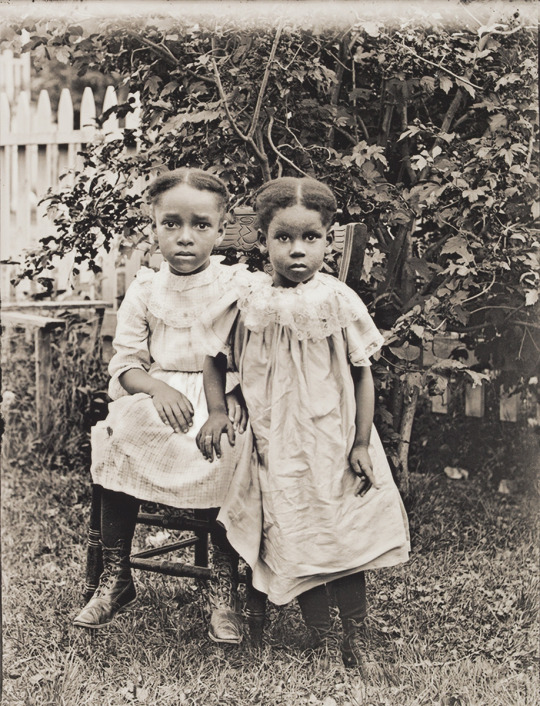
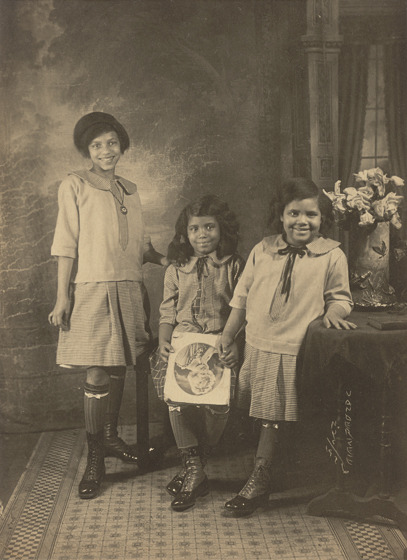
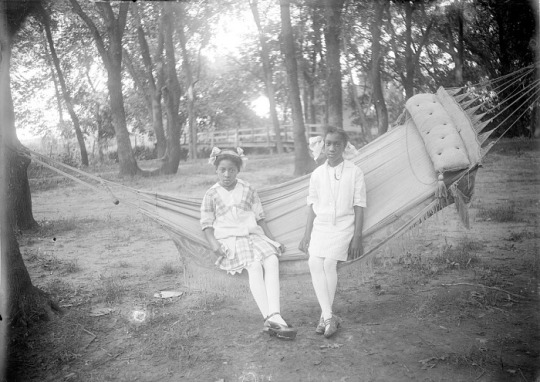
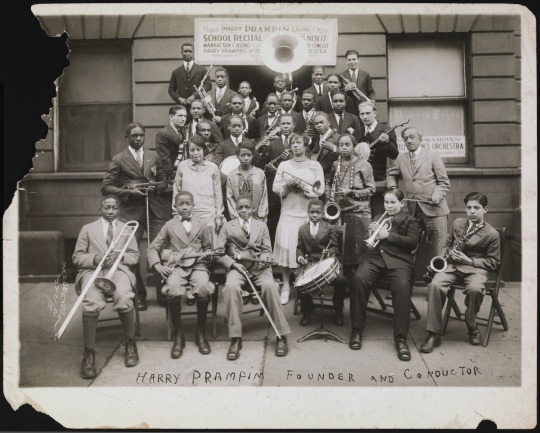
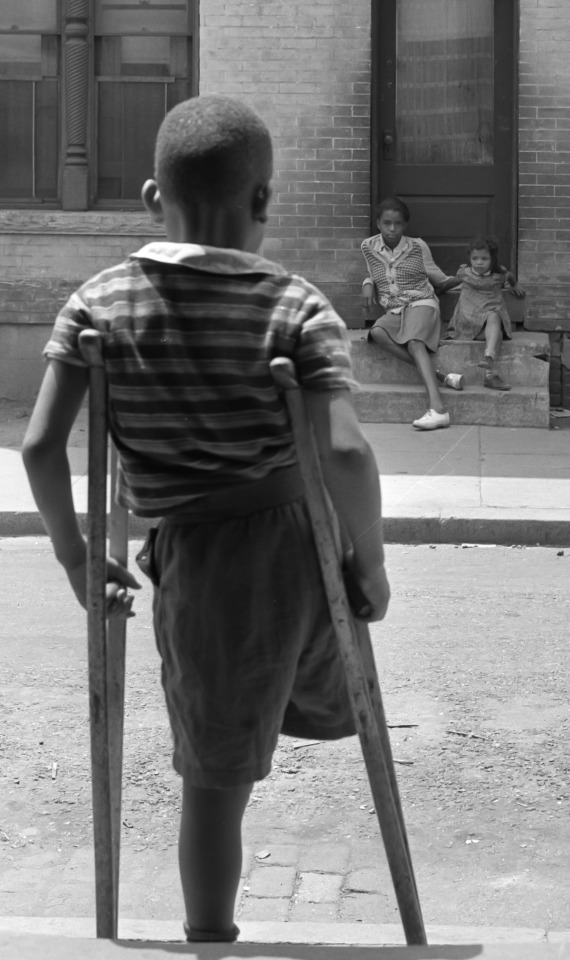
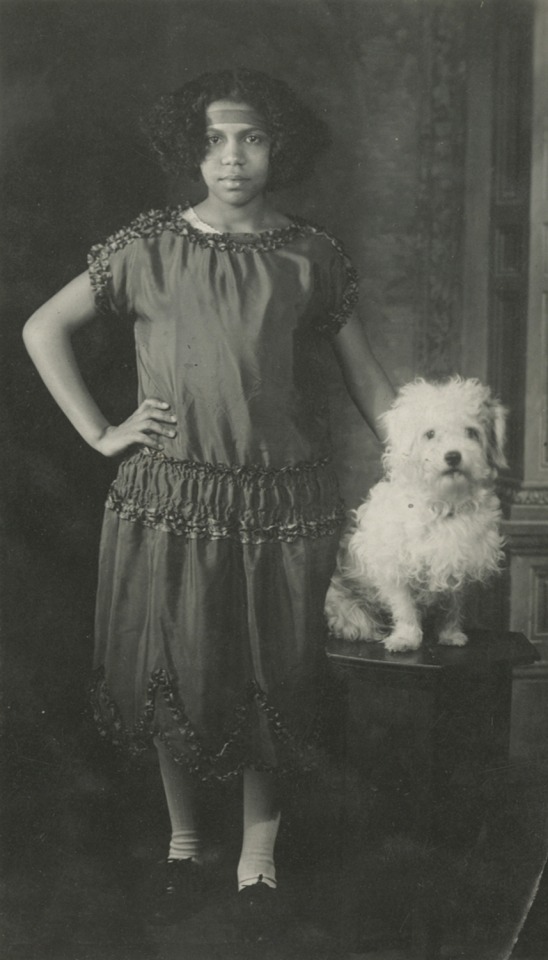
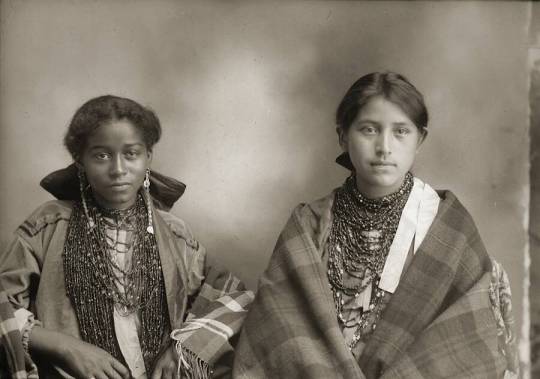

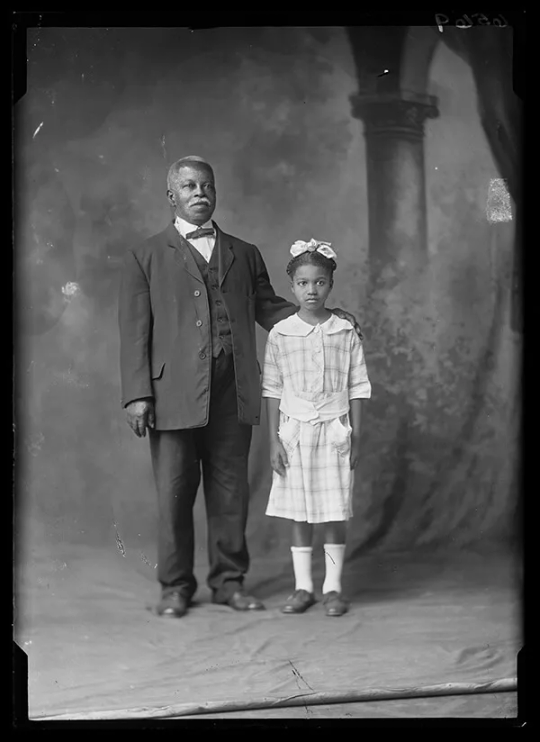
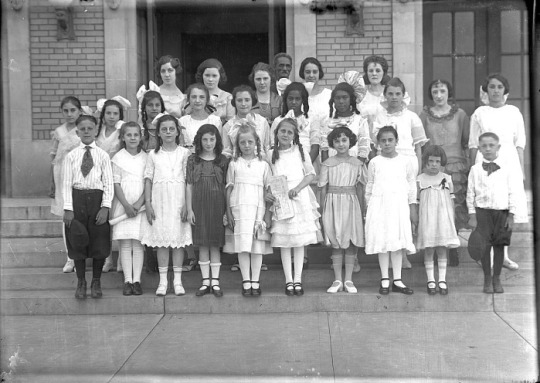
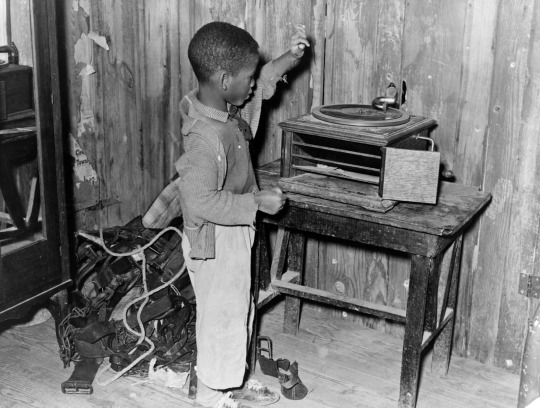
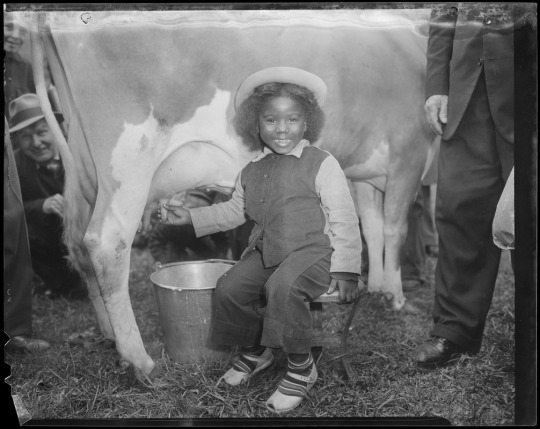



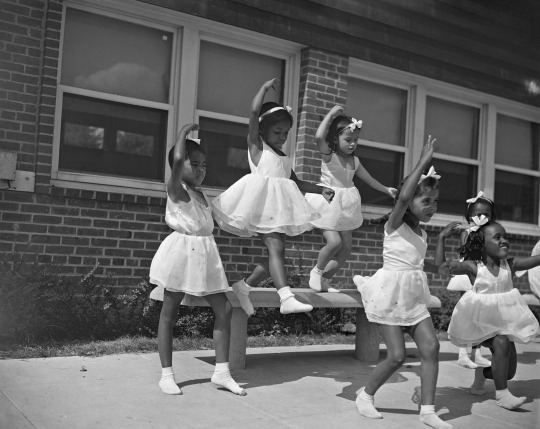
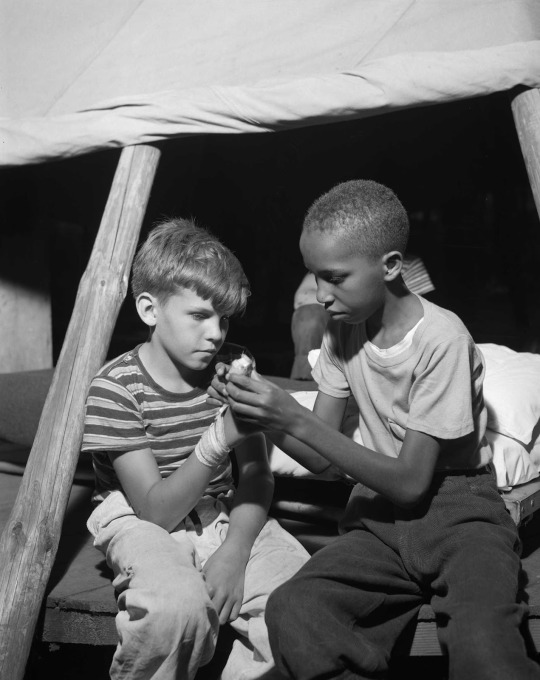
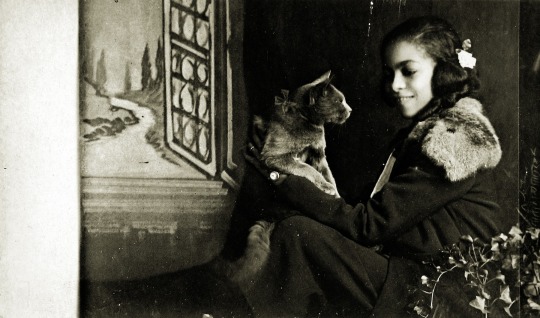
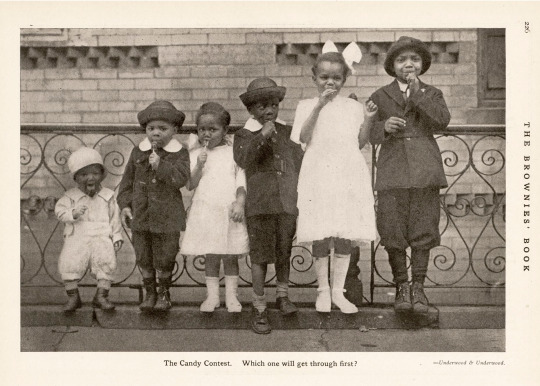
How do the memories and magic of children disrupt and upRoot the histories we tell ourselves? How do children navigate spaces of oppression and liberation? How do they find joy and hope in places that were not created for them to exist? They live.
(1) Portrait of two young Jackson girls in wrinkled, informal wear. Potentially the descendants of emancipated Virginian Bethany Veney, who authored a narrative of her life in slavery and went on to own three houses in Worcester's Beaver Brook neighborhood (1900)
(2) Three sister dressed in matching outfits (and shoes). The center girl holds a favorite object close, perhaps a record album (1926)
(3) Florence Jones (in white dress with large bow) and a friend swing on a family hammock in Lincoln, Nebraska (1915-1920)
(4) Students at the Harry Prampin School Recital in Harlem (1927)
(5) Washington, D.C. Young boy standing in the doorway of his home on Seaton Road in the northwest section. His leg was cut off by a streetcar while he was playing in the street (1942)
(6) A girl and her dog pose in a New York studio (1921)
(7) Ho-Chunk cousins Carrie Elksit (ENooKah) and Annie Lowe Lincoln (Red Bird) wearing elaborate beaded necklaces and earrings. Carrie (left) was the afroindigenous daughter of Lucie Elk, while Annie (right), was the daughter of King of Thunder in Black River Valley (1940)
(8) Ms. Ruby dons her Pullman maid’s uniform and and poses next to a young girl in Stafford County, Virginia (1904-1918)
(9) Eileen Buckner poses with her grandfather Anthony T. Buckner, who was born enslaved and would go on to be one the most respected merchants in the Charlottesville. Eileen's father, George W. Buckner, would go on to write the New Negro manifesto in 1921
(10) A girl smiles wide as she milks a cow (1934–1956)
(11) A young child plays the phonograph in his family cabin located at the Transylvania Project in Louisiana (1939)
(12) Two brown skinned girls pose in matching dresses near the center of their classroom picture in front of Lincoln High School, Nebraska (around 1919)
(13) A young sharecropper lays out on his attic bed in New Madrid County, Missouri (1938)
(14) Chris Easterling (left) and George Mashatt learn how to signal when they want the bus to stop in Ann Arbor (June 1975)
(15) A little girl watches the Macy’s Thanksgiving Day Parade with her family in New York (1946)
(16) Little ballerinas dance at the Frederick Douglass housing project located in Anacostia, D.C. (1942)
(17) Integrated summer activities at Camp Nathan Hale in Southfields, New York where children learned different skills, like first aid, under the guidance of the Methodist Camp Service (1943)
(18) A young girl smiles at her feline friend; notice the ribbon on the cat's neck (1925)
(19) Children stand in a line to pose during their candy eating competition W.E.B. DuBois' Brownies Book
Sources: Worcester Art Museum, James Van Der Zee Collection, Library of Congress, Harris & Ewing, Leslie Jones Collection, Boston Public Library, National Museum of African American History and Culture
33 notes
·
View notes
Text
Banned Native-Authored Children's Books (because of MAGA zealots)
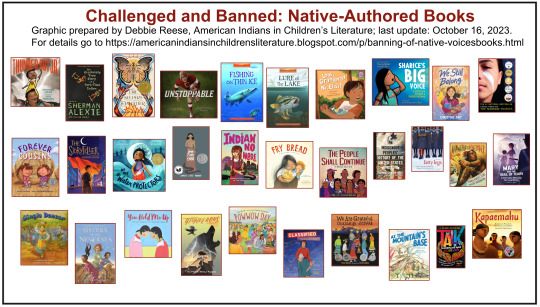
Firekeeper's Daughter written by Angeline Boulley (Sault Ste. Marie Tribe of Chippewa Indians)
Unstoppable: How Jim Thorpe and the Carlisle Indian School Football Team Defeated Army written by Art Coulson (Cherokee); illustrated by Nick Hardcastle (not Native)
Look, Grandma! Ni, Elisi! written by Art Coulson (Cherokee), illustrated by Madelyn Goodnight (Chickasaw)
Fishing on Thin Ice written by Art Coulson (Cherokee)
Lure of the Lake written by Art Coulson (Cherokee)
Sharice's Big Voice: A Native Kid Becomes a Congresswoman by Sharice Davids (Ho-Chunk); illustrated by Joshua Mangeshig Pawis-Steckley (Wasauksing)
We Still Belong by Christine Day (Upper Skagit); cover art by Madelyn Goodnight (Chickasaw)
The Marrow Thieves by Cherie Dimaline (Metis Nation of Ontario)
Forever Cousins by Laurel Goodluck (Mandan, Hidatsa and Tsimshian member); illustrated by Jonathan Nelson (Diné)
The Storyteller by Brandon Hobson (Cherokee)
We Are Water Protectors by Michaela Goade (Turtle Mountain Ojibwe); illustrated by Michaela Goade (Tlingit)
A Snake Falls to Earth by Darcie Little Badger (Lipan Apache)
Indian No More by Charlene Willing McManis (Confederated Tribes of Grande Ronde); cover art by Marlena Myles (Spirit Lake Dakota/Mohegan/Muscogee)
Fry Bread: A Native American Family Story by Kevin Maillard (Seminole); illustrated by Juana Martinez-Neal (not Native)
The People Shall Continue written by Simon Ortiz (Acoma Pueblo), illustrated by Sharol Graves (Absentee Shawnee Tribe of Oklahoma).
An Indigenous Peoples' History of the United States, for Young People by Debbie Reese (Nambé Owingeh) and Jean Mendoza (not Native), adapted from the original edition written by Roxanne Dunbar Ortiz (not Native)
Fatty Legs written by Margaret-Olemaun Pokiak-Fenton (Inuvialiut)
Hiawatha and the Peacemaker written by Robbie Robertson (Mohawk), illustrated by David Shannon (not Native)
Mary and the Trail of Tears by Andrea Rogers (Cherokee)
You Hold Me Up by Monique Gray Smith (Cree), illustrated by Danielle Daniel
Jingle Dancer by Cynthia Leitich Smith (Mvskoke), illustrated by Cornelius Van Wright (not Native) and Ying-Hwa Hu (not Native).
Sisters of the Neversea by Cynthia Leitich Smith (Mvskoke), cover illustration by Floyd Cooper (Mvskoke)
Thunderous written by M. L. Smoker (Assiniboine and Sioux tribes of Montana's Fort Peck Reservation) and Natalie Peeterse (not Native); illustrated by Dale Ray DeForest (Diné)
We Are Grateful written by by Traci Sorell (Cherokee Nation), illustrated by Frane Lessac (not Native)
At the Mountains Base written by Traci Sorell (Cherokee Nation), illustrated by Weshoyot Alvitre (Tongva, Cahuilla, Chumash, Spanish & Scottish)
"The Way of the Anigiduwagi" written by Traci Sorell (Cherokee Nation), illustrated by MaryBeth Timothy (Cherokee) in The Talk: Conversations about Race, Love and Truth edited by Cheryl and Wade Hudson
Classified: The Secret Career of Mary Golda Ross, Cherokee Aerospace Engineer written by Traci Sorell (Cherokee); illustrated by Natasha Donovan (Metis)
Powwow Day written by Traci Sorell (Cherokee); illustrated by Madelyn Goodnight (Chickasaw)
Kapaemahu written by Hinaleimoana Wong-Kalu (Kanaka Maoli), Dean Hamer (not Native), and Joe Wilson (not Native); illustrated by Daniel Sousa
[Full List by Debbie Reese]
#banned books#fuck maga#Native American#Native Hawaiian#Indigenous#books#Debbie Reese#Hinaleimoana Wong-Kalu#Dean Hamer#Joe Wilson#Daniel Sousa#Natasha Donovan#Traci Sorell#MaryBeth Timothy#Cheryl Hudson#Wade Husdon#Weshoyot Alvitre#Frane Lessac#Dale Ray DeForest#Natalie Peeterse#M. L. Smoker#Cynthia Leitich Smith#Floyd Cooper#Robbie Robertson#David Shannon#Monique Gray Smith#Danielle Daniel#Cornelius Van Wright#Ying-Hwa Hu#Andrea Rogers
20 notes
·
View notes
Note
Had any military leader in Gaia made bold, seemingly crazy ventures against their enemy that worked surprisingly well? Like for example Hannibal’s crossing of the alps, managing to drag a massive army and war elephants through massive icy mountains just to kick romes ass?
What a fun question!
Once when Zareen Empire and Mogdir Kingdom were at war, Zareen sent a giant bronze statue to Mogdir Capital as a peace offering. And when I say "giant", I really mean colossal! It would be the tallest, most impressive structure in Mogdir Kingdom.
Mogdir accepted it, but little did they know, this was a trick. Once it was brought to the capital city, the statue emitted a huge plume of toxic smog that covered the Arcadian Forest for weeks, enraging the local nymphs and prompting them to attack Mogdiri settlements.
In Mogdir's moment of weakness, Zareen was able to move in and do some real damage. The smog itself caused a lot of damage to soil, crops, and people for years to come. The mountain range separating the two kingdoms blocked the smog from drifting back into Zareenite territory, so they were largely shielded from the consequences.
But don't worry, Mogdir Kingdom got revenge centuries later when they agreed to release a thousand Zareenite prisoners of war. Zareen took the prisoners back into their homeland...only to find out that they had all been infected with lycanthropy. This began a wave of plague and chaos that took decades for Zareen to get under control.
There was also the time Etios Nation got so mad at Matuzu, they started a campaign to dump all the nation's sewage into the river that flows into Matuzu's Central Lake. This was incredibly expensive and inconvenient for Etios, and quite frankly...insane. But the nation's people were totally on board to #shitonmatuzu, and it didn't take long before Central Lake became a biohazard and Matuzu was forced to work out some kind of deal with Etios, granting them a big chunk of land that they still own to this day. Since then, local nymphs have prevented Etios from pulling this maneuver again, citing ecological damage. But for that brief moment in history, the Etiosi could tell Matuzu to "eat shit" and mean it!
Last but not least: the Seelie Court once had a territory dispute with the Unseelie Court (what else is new?) They were fighting over an island that sat right on the border. This island was abundant with resources, so it was valuable to them both. Queen Titania of the Seelie suggested that they break the island in half and divide the resources evenly, but Overlord Morgause was like, "FUCK U HO, EITHER I GET IT OR NO ONE DOES!" and just blew up the whole island. As in, fully wiped it off the map. Morgause didn't get any of its resources...but the important thing is, neither did Titania. B) Also thousands of innocent islanders died, but we don't talk about that...
*
Questions/Comments?
Lore Masterpost
Read the Series
7 notes
·
View notes
Text

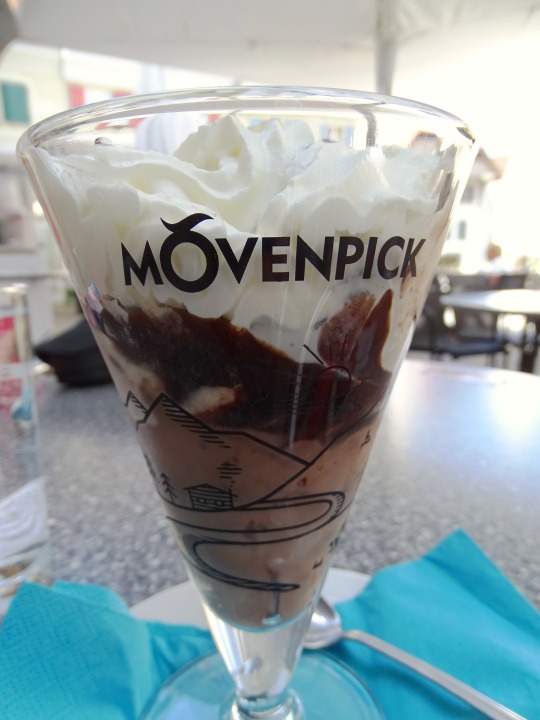
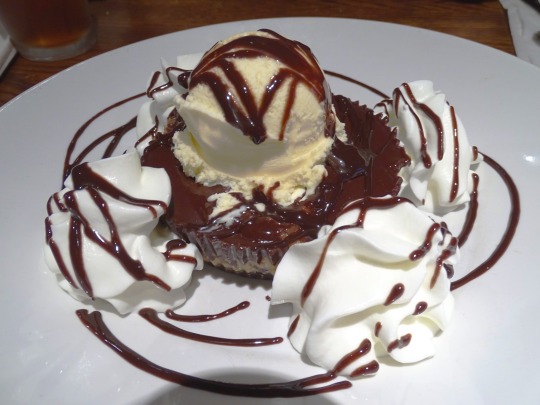
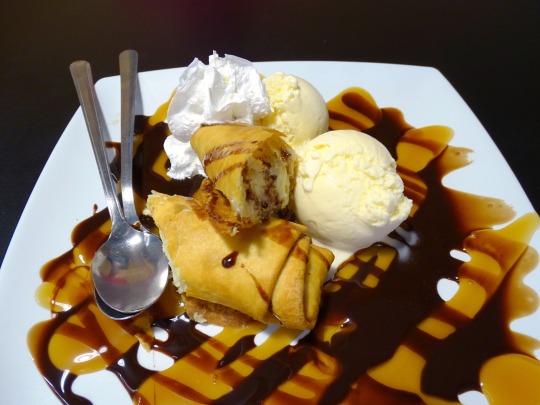


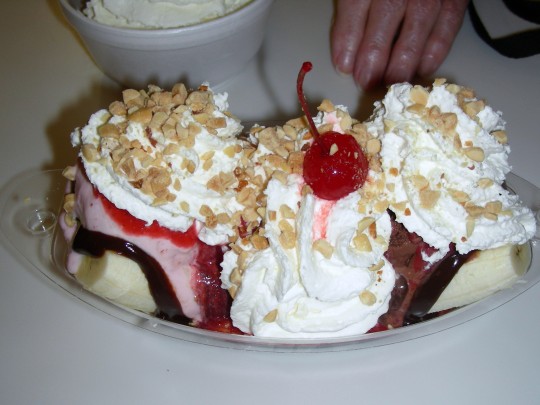
National Hot Fudge Sundae Day
Fudge and ice cream, one of the greatest combos in the world: head to an ice cream parlor, or make your own tasty, creamy, sweet hot fudge sundae at home.
It’s hard to go wrong with ice cream—no matter what you do with it, it seems like it always results in something delicious. Ice cream sandwiches, ice cream cake, milkshakes, ice cream fondue…need we say more? And one of the few things that can make ice cream even better than it is thick, hot, sweet fudge. Fudge and ice cream…if that’s not a reason for celebration, what is?
Learn About National Hot Fudge Sundae Day
National Hot Fudge Sundae Day gives us all the perfect excuse to indulge in this delicious, sweet treat. It is all about celebrating the invention of this dessert, and what better way to celebrate than eating a sundae?
A sundae is simply an ice cream dessert that usually consists of one or more scoops of ice cream, which then has a syrup or sauce on top, with a number of other toppings added. This could be maraschino cherries, peanuts, marshmallows, whipped cream, or sprinkles. We also see a lot of dessert parlours adding chopped up chocolate bars to sundaes today, with everything from popping candy to candyfloss incorporated into the latest inventions.
Of course, a Hot Fudge Sundae needs to have two critical ingredients: hot fudge sauce and ice cream. After this, there are plenty of different adaptions of the treat. Some people add walnuts to their sundae, in order to give the dessert a good crunch.
You can also add fudge pieces or some chocolate drops. If you want to add some fruit into the mix, cherries are often teamed with hot fudge sundaes. Or, why not add some delicious and gooey chunks of brownie? The choice is yours! That’s what makes a sundae so great; it is all about putting your favorite ingredients into one big dessert glass and enjoying the magic it creates!
Record-breaking sundaes
If you thought you were the biggest fan of sundaes, you may have to concede defeat when you read about some of these World Records! For example, the longest sundae was created in March of 2018. It measured more than 4,549 feet long! It was created in College Station at the Spirit of Texas festival.
The most expensive sundae can also be found in the United States. If you are willing to pay $25,000, you can enjoy the world’s most expensive sundae in New York City at Serendipity 3. The owner of Serendipity 3, Stephen Bruce, teamed up with Euphoria, a luxury jeweler, in order to create the Frozen Haute Chocolate sundae.
The sundae included 28 different cocoas, with 14 of the world’s most exotic and expensive cocoas. The dessert, which is spelled with two Rs, is served in a goblet that is lined with edible gold, and it is infused with five grams of edible 23-karat gold. It is then topped with whipped cream, which has more gold on the top. One the side, you will get a La Madeline au Truffle from Knipschildt Chocolatier. This sells for $2,600 per pound.
History of the National Hot Fudge Sundae Day
Why we call sundaes, sundaes is not precisely known, though it is probably simply connected to the fact that ice cream with nuts, sprinkles, fruit, whipped cream and various syrups used to be a treat reserved only for the weekends.
Sundaes first appeared in the early 1900s, and with a few years there were already countless variations of it, such as the Robin Hood sundae, Cocoa Caramel sundae, Black Hawk sundae, Angel Cake sundae, Cherry Dip sundae, Cinnamon Peak sundae, Opera sundae, Fleur D’Orange sundae, Knickerbocker sundae, Tally-Ho Sundae, Bismarck and George Washington sundae, to name but a few.
American-style fudge was first made in Baltimore, Maryland, in 1886, and its popularity soon expanded.
These two delicious foodstuffs were first combined in 1906 at C.C. Browns, an ice cream parlour on Hollywood Boulevard in Los Angeles, and the hot fudge sundae was born. Today, even Google recognizes this holiday as an official holiday!
How to celebrate National Hot Fudge Sundae Day
Are you ready to give your taste buds the treat of their lives? If so, National Hot Fudge Sundae Day could be your new favorite holiday! To celebrate it, you could go out to an ice cream parlor to enjoy one, or you could make one yourself.
One fun way to celebrate hot fudge sundae day is to get your friends around and you can all create your own hot fudge sundaes together. Create a station with lots of different toppings, from brownies and popcorn to sprinkles and marshmallows.
You can then all have a lot of fun together making your own creations. This is a great way to spend time with those you love while doing something a bit different to the norm!
So are you ready to celebrate this deliciously sweet little holiday? We know we are!
Source
#Sticky Toffee Chocolate Pudding#Chocolate Peanut Butter Cup a la Mode#tourist attraction#Fried Cheesecake#Fried Ice Cream#Mövenpick ice cream#Banana Split#dessert#food#restaurant#original photography#travel#USA#vacation#National Hot Fudge Sundae Day#25 July#Canada
2 notes
·
View notes
Text
Ho-Chunk are part of Wisconsin’s living history
After a period of forced removal in the mid-1800s, the Ho-Chunk people continue to shape Wisconsin’s culture and economy.
By Richelle Wilson– Wisconsin Public Radio When Josie Lee from the Ho-Chunk Nation looks at Wisconsin today, she sees the impact of her tribe on the state. “If it weren’t for Ho-Chunk people, we wouldn’t have the state as it exists today,” Lee told WPR’s “Wisconsin Today.” “You wouldn’t have such a large agricultural industry with cranberries if it weren’t for seasonal Ho-Chunk migrant workers…
#afternoon update#culture of Wisconsinites#Ho Chunk Nation#Ho-Chunk Nation Museum Cultural Center#Wisconsin Public Radio
0 notes
Photo

Twelve Famous Native American Women
Native American women are traditionally held in high regard among the diverse nations, whether a given people are matrilineal or patrilineal. Traditionally, women were not only responsible for raising children and caring for the home but also planted and harvested the crops, built the homes, and engaged in trade, as well as having a voice in government.
The history of the women of the Native peoples of North America attests to their full participation in the community whether as elders and "medicine women" or as skilled agriculturalists and merchants and, in some cases, even warriors. Although hunting and warfare were traditionally the provenance of males, some women became famous for their courage and skill in battle. These women, as well as others in the arts and sciences, are often overlooked because they do not fit the paradigm of what has been accepted as American history.
Pocahontas and Sacagawea are usually the only North American Native women that non-Natives have heard of, but even their narratives have been obscured by legend and half-truths. Many other Native American women have simply been ignored, and among them are most of those listed below. These women, and the nations they were citizens of, include:
Jigonhsasee – Iroquois
Pocahontas – Powhattan
Weetamoo – Wampanoag
Glory-of-the-Morning – Ho-Chunk/Winnebago
Sacagawea – Shoshone
Old-Lady-Grieves-the-Enemy – Pawnee
Pine Leaf/Woman Chief – Crow
Lozen – Apache
Buffalo Calf Road Woman – Cheyenne
Thocmentony/Sarah Winnemucca – Paiute
Susan La Flesche Picotte – Omaha
Molly Spotted Elk/Mary Alice Nelson – Penobscot
There are many others who do not appear here because they are more widely known, such as the Yankton Dakota activist, musician, and writer, Zitkala-Sa (l. 1876-1938) or the Cheyenne warrior Mochi ("Buffalo Calf", l. c. 1841-1881). Modern-day figures are also omitted but deserve mention, such as the activist Isabella Aiukli Cornell of the Choctaw nation, who drew national attention in 2018 with her red prom dress designed to call attention to the many missing and murdered indigenous women across North America, and poet/activist Suzan Shown Harjo of the Muscogee/Southern Cheyenne nation. There are many more, like these two, who have devoted themselves to raising awareness of the challenges facing Native Americans and continue the same struggle, in various ways, as the women of the past.
Jigonhsasee (l. c. 1142 or 15th century)
According to Iroquois lore, Jigonhsasee (Jikonhsaseh, Jikonsase) was integral to the origins of the Haudenosaunee (Iroquois) Confederacy dated to either the 12th or 15th century. She was an Iroquoian whose home was along the central path used by warriors going to and from battle and became well-known for the hospitality and wise counsel she offered them. The Great Peacemaker (Deganawida) chose her to help him form the Iroquois Confederacy, based on the model of a family living together in one longhouse, and, along with Hiawatha, this vision became a reality. Jigonhsasee became known as the 'Mother of Nations' and established the policy of women choosing the chiefs of the council in the interests of peace, instead of war. The American women's suffrage movement of the 19th century called attention to the freedom and rights of Native American women, notably those of the Iroquois Confederacy, in arguing for those same rights for themselves.
Continue reading...
95 notes
·
View notes
Text


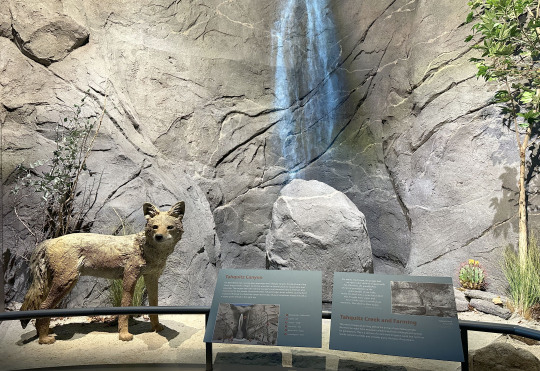

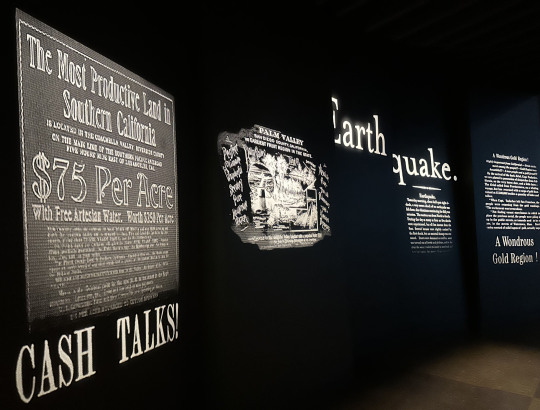
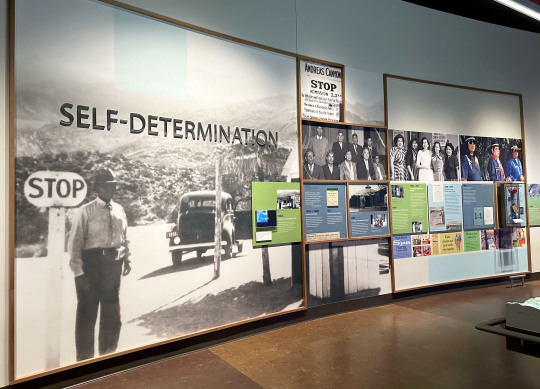

The Agua Caliente Cultural Museum opened in 2023 in a new location in Palm Springs as part of the Agua Caliente Cultural Plaza. It consists of several exhibition areas that tell the story of the Agua Caliente Band of Cahuilla Indians. These include an immersive digitally animated film in a theater at the entrance, scale replicas of the Indian Canyons, and videos, historical photographs and documents. The museum also includes several artifacts including those found during excavations for the plaza that are over 7,000 years old.
The museum also has a gallery for rotating exhibitions focused on traditional and contemporary Native American art. Currently on view is For a Love of His People, the black and white photography of Horace Poolaw.
From the museum–
Horace Poolaw (Kiowa, 1906-1984) was born during a time of great change for his people—one year before Oklahoma statehood and six years after the U.S. government approved an allotment policy that ended the reservation period. A rare American Indian photographer who documented Indian subjects, he began making a visual history in the mid-1920s and continued for the next 50 years.
Poolaw photographed his friends and family, and events important to them—weddings, funerals, parades, fishing, driving cars, going on dates, going to war, playing baseball. When he sold his photos at fairs and community events, he often stamped the reverse: “A Poolaw Photo, Pictures by an Indian, Horace M. Poolaw, Anadarko, Okla.” Not simply by “an Indian,” but by a Kiowa man strongly rooted in his multi-tribal community, Poolaw’s work celebrates his subjects’ place in American life and preserves an insider’s perspective on a world few outsiders are familiar with—the Native America of the Southern Plains during the mid-20th century.
Organized around the central theme of Poolaw as a man of his community and time, For a Love of His People is based on the Poolaw Photography Project, a research initiative established by Poolaw’s daughter, Linda, in 1989 at Stanford University and carried on by Native scholars Nancy Marie Mithlo (Chiricahua Apache) and Tom Jones (Ho-Chunk) of the University of Wisconsin-Madison.
For a Love of His People: The Photography of Horace Poolaw is organized by the Smithsonian National Museum of the American Indian. The exhibition was curated by Tom Jones (Ho-chunk) and Nancy Marie Mithlo (Chiricahua Apache).
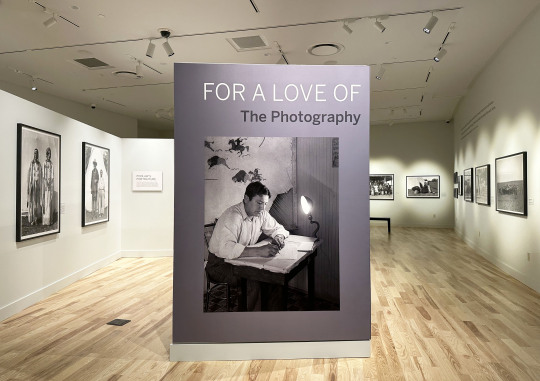
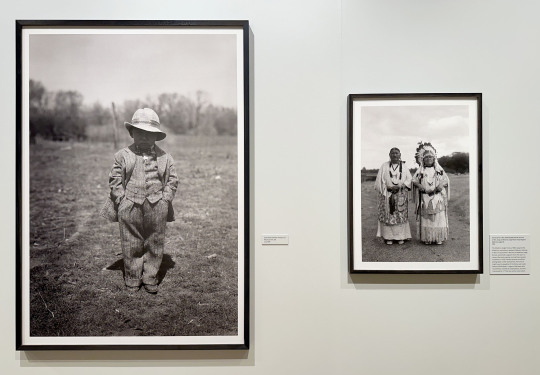
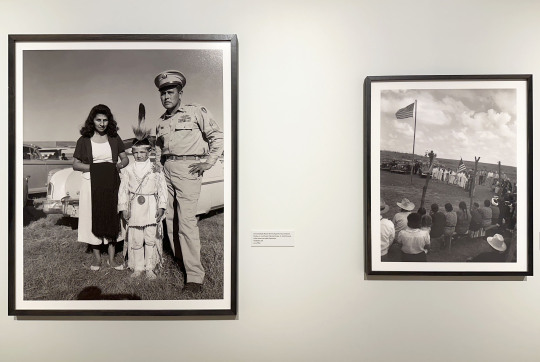
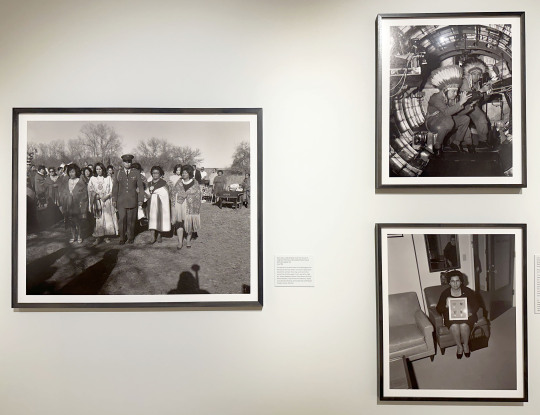


#Agua Caliente Cultural Museum#Horace Poolaw#Agua Caliente Cultural Plaza#Agua Caliente#Agua Caliente Band of Cahuilla Indians#Artifacts#Black and White Photography#Cahuilla Indians#Palm Springs Museum#California Museum#Coachella Valley#Indigenous Peoples Day#Tom Jones#Museum#Nancy Marie Mithlo#Native American Art#Native American Artists#Native American History#Photography#Places to Visit#Smithsonian National Museum of the American Indian
1 note
·
View note
Text
Student reflections: What does Indigenous Peoples’ Day mean to me?
In honor of Indigenous Peoples’ Day, Marquette Today is spotlighting reflections written by some of our diverse Native student body. Through their distinct lens, these students offer a potent restorative history of Indigenous peoples never discovered and defiantly resilient. Janiah Stewart, Ho-Chunk Nation, freshman majoring in political science and criminology Janiah Stewart Indigenous…
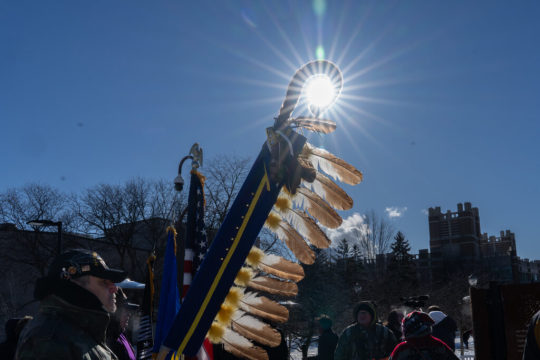
View On WordPress
0 notes
Text
[image description: screen captures of a poem. Image text copied and pasted from https://onbeing.org/poetry/38/ where you can also listen to the poet read the work.
FYI there are a few lines at the end with variant line formatting by the poet that I attempted to recreate using extra spaces. That might sound odd via screen reader.]
38
Here, the sentence will be respected.
I will compose each sentence with care, by minding what the rules of writing dictate.
For example, all sentences will begin with capital letters.
Likewise, the history of the sentence will be honored by ending each one with appropriate punctuation such as a period or question mark, thus bringing the idea to (momentary) completion.
You may like to know, I do not consider this a “creative piece.”
I do not regard this as a poem of great imagination or a work of fiction.
Also, historical events will not be dramatized for an “interesting” read.
Therefore, I feel most responsible to the orderly sentence; conveyor of thought.
That said, I will begin.
You may or may not have heard about the Dakota 38.
If this is the first time you’ve heard of it, you might wonder, “What is the Dakota 38?”
The Dakota 38 refers to thirty-eight Dakota men who were executed by hanging, under orders from President Abraham Lincoln.
To date, this is the largest “legal” mass execution in US history.
The hanging took place on December 26, 1862—the day after Christmas.
This was the same week that President Lincoln signed the Emancipation Proclamation.
In the preceding sentence, I italicize “same week” for emphasis.
There was a movie titled Lincoln about the presidency of Abraham Lincoln.
The signing of the Emancipation Proclamation was included in the film Lincoln; the hanging of the Dakota 38 was not.
In any case, you might be asking, “Why were thirty-eight Dakota men hung?”
As a side note, the past tense of hang is hung, but when referring to the capital punishment of hanging, the correct past tense is hanged.
So it’s possible that you’re asking, “Why were thirty-eight Dakota men hanged?”
They were hanged for the Sioux Uprising.
I want to tell you about the Sioux Uprising, but I don’t know where to begin.
I may jump around and details will not unfold in chronological order.
Keep in mind, I am not a historian.
So I will recount facts as best as I can, given limited resources and understanding.
Before Minnesota was a state, the Minnesota region, generally speaking, was the traditional homeland for Dakota, Anishinaabeg, and Ho-Chunk people.
During the 1800s, when the US expanded territory, they “purchased” land from the Dakota people as well as the other tribes.
But another way to understand that sort of “purchase” is: Dakota leaders ceded land to the US government in exchange for money or goods, but most importantly, the safety of their people.
Some say that Dakota leaders did not understand the terms they were entering, or they never would have agreed.
Even others call the entire negotiation “trickery.”
But to make whatever-it-was official and binding, the US government drew up an initial treaty.
This treaty was later replaced by another (more convenient) treaty, and then another.
I’ve had difficulty unraveling the terms of these treaties, given the legal speak and congressional language.
As treaties were abrogated (broken) and new treaties were drafted, one after another, the new treaties often referenced old defunct treaties, and it is a muddy, switchback trail to follow.
Although I often feel lost on this trail, I know I am not alone.
However, as best as I can put the facts together, in 1851, Dakota territory was contained to a twelve-mile by one-hundred-fifty-mile long strip along the Minnesota River.
But just seven years later, in 1858, the northern portion was ceded (taken) and the southern portion was (conveniently) allotted, which reduced Dakota land to a stark ten-mile tract.
These amended and broken treaties are often referred to as the Minnesota Treaties.
The word Minnesota comes from mni, which means water; and sota, which means turbid.
Synonyms for turbid include muddy, unclear, cloudy, confused, and smoky.
Everything is in the language we use.
For example, a treaty is, essentially, a contract between two sovereign nations.
The US treaties with the Dakota Nation were legal contracts that promised money.
It could be said, this money was payment for the land the Dakota ceded; for living within assigned boundaries (a reservation); and for relinquishing rights to their vast hunting territory which, in turn, made Dakota people dependent on other means to survive: money.
The previous sentence is circular, akin to so many aspects of history.
As you may have guessed by now, the money promised in the turbid treaties did not make it into the hands of Dakota people.
In addition, local government traders would not offer credit to “Indians” to purchase food or goods.
Without money, store credit, or rights to hunt beyond their ten-mile tract of land, Dakota people began to starve.
The Dakota people were starving.
The Dakota people starved.
In the preceding sentence, the word “starved” does not need italics for emphasis.
One should read “The Dakota people starved” as a straightforward and plainly stated fact.
As a result—and without other options but to continue to starve—Dakota people retaliated.
Dakota warriors organized, struck out, and killed settlers and traders.
This revolt is called the Sioux Uprising.
Eventually, the US Cavalry came to Mnisota to confront the Uprising.
More than one thousand Dakota people were sent to prison.
As already mentioned, thirty-eight Dakota men were subsequently hanged.
After the hanging, those one thousand Dakota prisoners were released.
However, as further consequence, what remained of Dakota territory in Mnisota was dissolved (stolen).
The Dakota people had no land to return to. This means they were exiled.
Homeless, the Dakota people of Mnisota were relocated (forced) onto reservations in South Dakota and Nebraska.
Now, every year, a group called the Dakota 38 + 2 Riders conduct a memorial horse ride from Lower Brule, South Dakota, to Mankato, Mnisota.
The Memorial Riders travel 325 miles on horseback for eighteen days, sometimes through sub-zero blizzards.
They conclude their journey on December 26, the day of the hanging.
Memorials help focus our memory on particular people or events.
Often, memorials come in the forms of plaques, statues, or gravestones.
The memorial for the Dakota 38 is not an object inscribed with words, but an act.
Yet, I started this piece because I was interested in writing about grasses.
So, there is one other event to include, although it’s not in chronological order and we must backtrack a little.
When the Dakota people were starving, as you may remember, government traders would not extend store credit to “Indians.”
One trader named Andrew Myrick is famous for his refusal to provide credit to Dakota people by saying, “If they are hungry, let them eat grass.”
There are variations of Myrick’s words, but they are all something to that effect.
When settlers and traders were killed during the Sioux Uprising, one of the first to be executed by the Dakota was Andrew Myrick.
When Myrick’s body was found,
his mouth was stuffed with grass.
I am inclined to call this act by the Dakota warriors a poem.
There’s irony in their poem.
There was no text.
“Real” poems do not “really” require words.
I have italicized the previous sentence to indicate inner dialogue, a revealing moment.
But, on second thought, the words “Let them eat grass” click the gears of the poem into place.
So, we could also say, language and word choice are crucial to the poem’s work.
Things are circling back again.
Sometimes, when in a circle, if I wish to exit, I must leap.
And let the body swing.
From the platform.
Out
to the grasses.
[end image description]
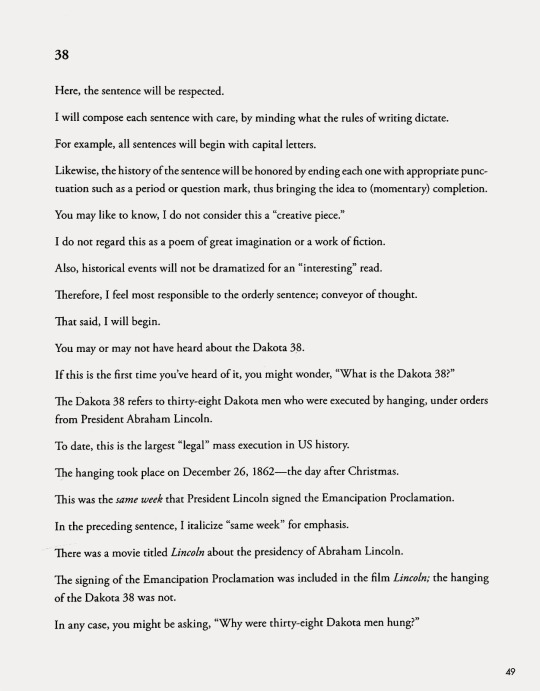
Layli Long Soldier, 38, in WHEREAS, Graywolf Press, Minneapolis, MN, 2017, p. 49-53
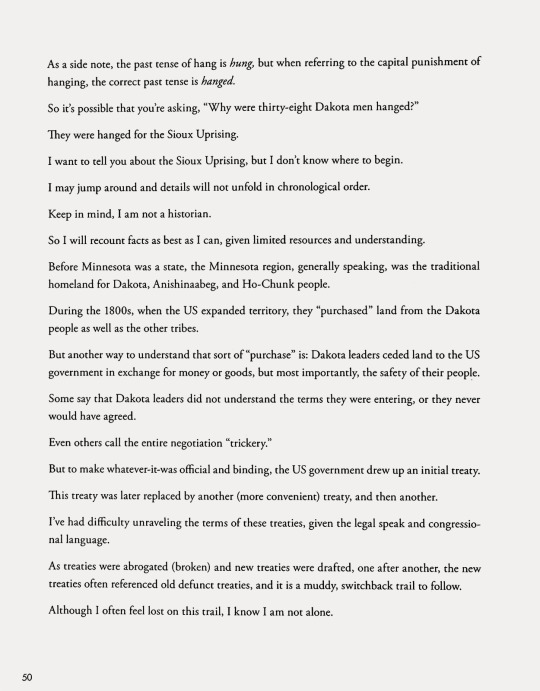
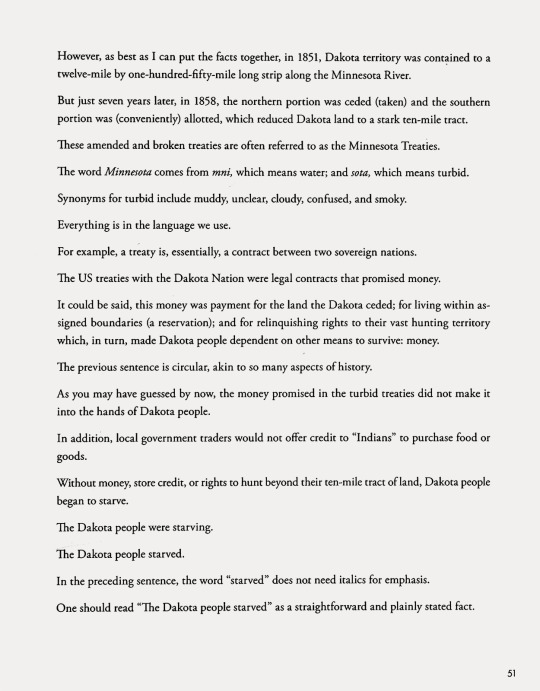
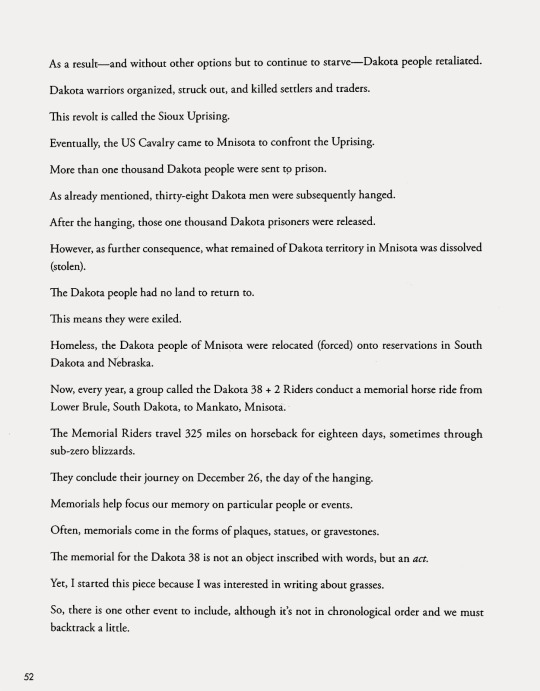
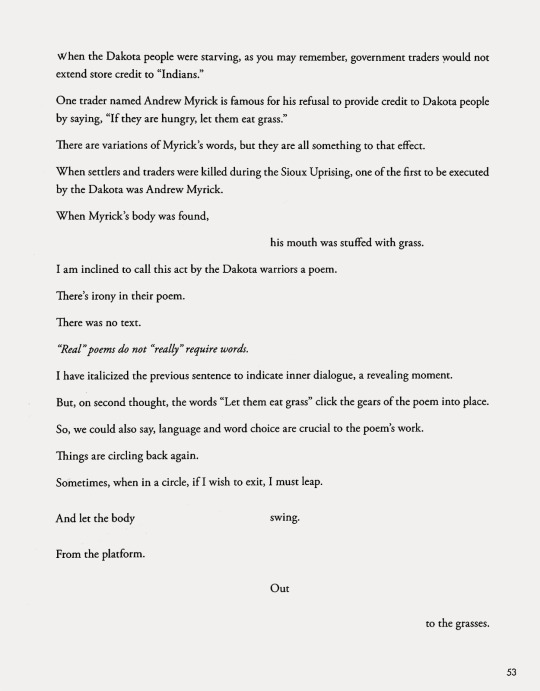
42 notes
·
View notes